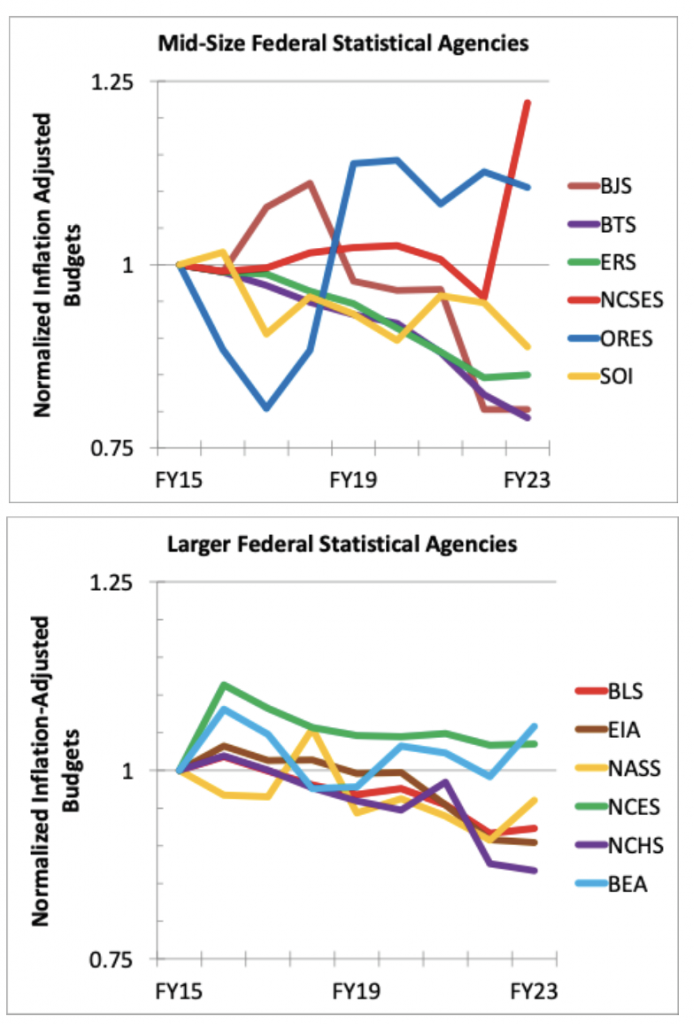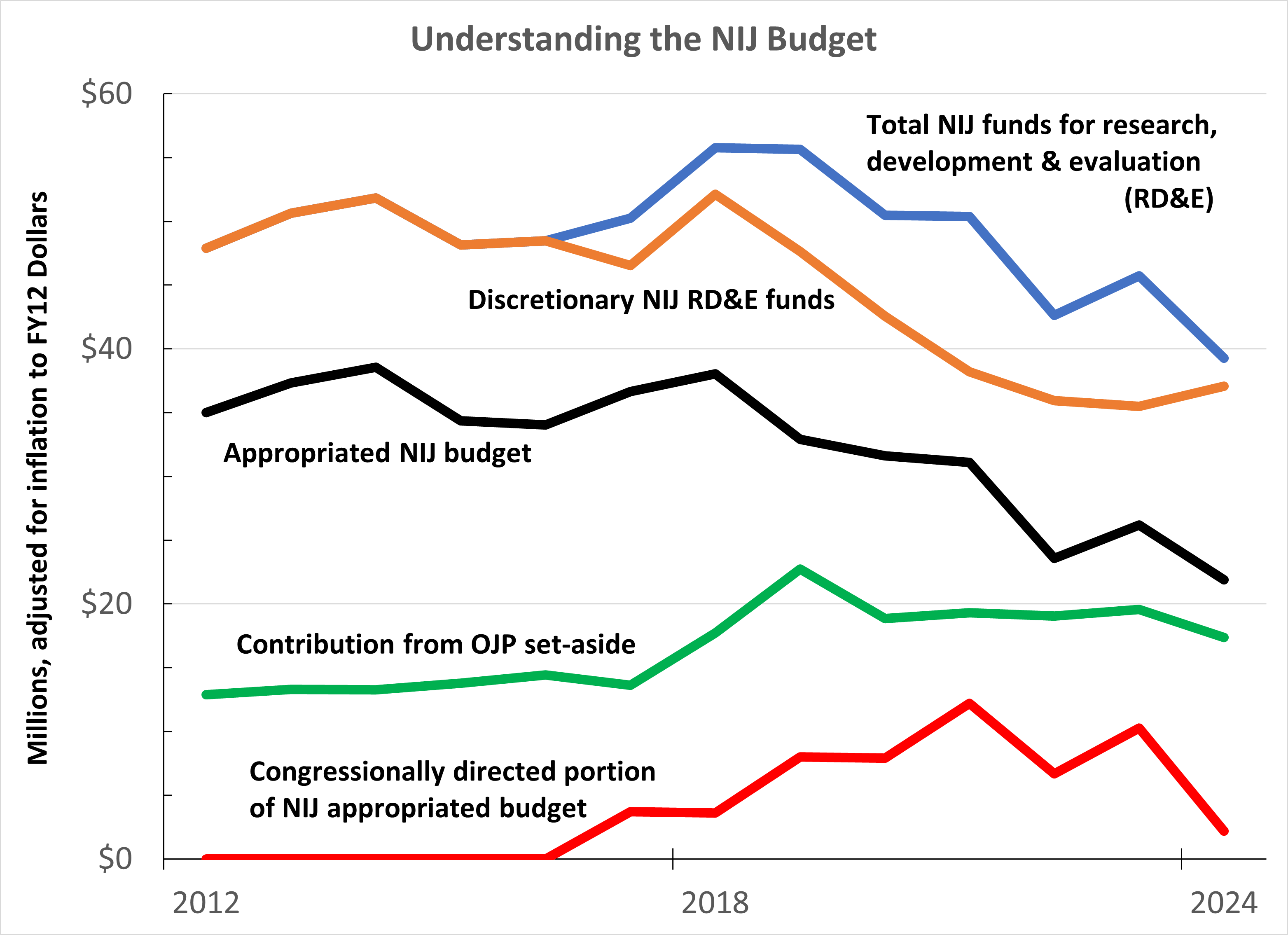FY23 Budgets, FY24 Budget Request Show Strong Support for Research, Statistical Agencies
Steve Pierson, ASA Director of Science Policy
The December deal to fund the US government for the current fiscal year included an increase of 14% for the National Science Foundation and 6% for the National Institutes of Health, along with double-digit percent increases for several statistical agencies. Released in March, the president’s requested budget for fiscal year 2024 (FY24) also has favorable increases for the agencies but will face the new Republican majority in the US House of Representatives, where there is a desire to reduce federal government spending to FY22 levels.

Final FY23 Budget
NSF’s increase of $1 billion in FY23 demonstrates strong bipartisan support for its mission and especially its new Directorate for Technology, Innovation, and Partnerships, which expands NSF’s work beyond basic research as enacted in the 2022 CHIPS and Science Act. The TIP directorate and many STEM education components of the CHIPS and Science Act present new funding opportunities for members of the statistical community.
The NIH increase of $3 billion sustains the bipartisan and bicameral commitment to increasing support for biomedical research.
Three federal statistical agencies received double-digit percentage increases: Bureau of Economic Analysis (12%); National Agricultural Statistics Service (11%); and National Center for Science and Engineering Statistics (34%). For BEA, Congress specified $1.5 million of the $14 million increase be used for implementing the Outdoor Recreation Jobs and Economic Impact Act of 2016. With the balance, BEA presumably has the latitude to carry out its FY23 initiatives, which includes Evidence Act implementation, developing new data to track American competitiveness in global supply chains, and accelerating improved measures of the US health care sector.
The NASS increase is for its quinquennial Census of Agriculture, commodity surveys, and geospatial program.
The NCSES increase is in support of its government-wide evidence-building activities and initiatives, including its implementation of the National Secure Data Service pilot through the expansion of America’s DataHub. Congress also encouraged NSF in its report language for the NSF funding bill “to address NCSES staffing to allow the center to build its in-house capacity and expertise to perform its work nimbly, efficiently, and in a cost-efficient manner.”
Except for the marginal increase for the Bureau of Transportation Statistics and 2% cut for Statistics of Income, the other agencies received single-digit percentage increases of at least three percent. The $7 million for the National Center for Health Statistics is notable for it being the largest increase in more than a dozen years but still leaves the agency having lost 20% in purchasing power since FY10. That percentage is so large in part because of the 4% inflation rate of 2021 over 2020, 7% of 2022 over 2021, and an estimated 5% of 2023 over 2022.
The NCES level is also notable because the $10 million increase to its statistics line is the largest since 2010 and helps offset its 19% loss in purchasing power since 2010. Referencing the Institute of Education Sciences, the explanatory statement for the Labor, Health and Human Services, Education and Related Agencies Appropriations Bill references the 2022 report from the National Academies of Science, Engineering, and Medicine Committee on National Statistics, A Vision and Roadmap for Education Statistics, and especially encourages the Department of Education and IES to provide NCES more professional autonomy:
Despite the increases for many statistical agencies, most have lost considerable purchasing power, as shown in Figure 1. Four of the 12 agencies shown have kept up with inflation: Bureau of Economic Analysis; National Center for Education Statistics; National Center for Science and Engineering Statistics; and Social Security Administration’s Office of Research, Evaluation, and Statistics. The Bureau of Justice Statistics has lost 20% in purchasing power since 2015, the Bureau of Labor Statistics has lost 8%, the Economic Research Service has lost 15%, and the Energy Information Administration has lost 10%.

Figure 1: Budgets for mid-sized and larger statistical agencies adjusted for inflation using the GDP deflator and normalized to their FY15 levels
The FY23 budget also marked a major development for federal statistics, namely the inclusion of $3.9 million for the Office of Immigration Statistics in the Department of Homeland Security to “address an increasing workload and to establish a new Office of Homeland Security Statistics (OHSS) that will operate as an independent statistical unit.” The ASA is tracking this development and seeking to ensure the agency has the professional autonomy recommended to facilitate trust in its products.
National Institute of Justice
Under the guidance of the ASA Committee on Forensic Science, the ASA urged Congress in letters written in 2022 and 2023 to increase the budget of the National Institute of Justice, noting, for example, that since “peak funding in FY15 of nearly $30 million for forensic science research and development, funding fell to $13 million in FY22.”
NIJ receives funding through both a line item in the congressional appropriations process and a congressional 2% research and statistics set-aside, whereby NIJ receives 1% of the programmatic funds provided to the Office of Justice Programs. (The Bureau of Justice Statistics also received 1% through the set-aside). While the set-aside amount climbed to $13 million in FY23 in addition to the NIJ-appropriated budget of $35 million, the amount of funds for research, development, and evaluation over which NIJ has discretion to distribute has shrunk 40% since 2018 due to inflation and growth of congressional mandates on NIJ spending.
These NIJ funding dynamics are depicted in Figure 2, in which amounts have been adjusted for inflation to 2012 dollars. The black line is the NIJ-appropriated funding, and the green line is the set-aside funding. The blue line is the total of the appropriated and set-aside funding. The red line is the dollar amount associated with the congressional carve-outs of NIJ’s funding, designating specific amounts of support for specific programs (e.g., $7.5 million in FY23 for research on domestic radicalization.) The orange line subtracts the carve-out funding from the total NIJ research, development, and evaluation funds, yielding NIJ’s discretionary research, development, and evaluation budget and illustrating the sharp drop.

Figure 2: The NIJ budget and components, including its congressional appropriated budget and a set-aside based on the Office of Justice Programs programmatic budget and congressional carveouts, all adjusted for inflation to 2012 dollars. Data source: NIJ
This graph was updated from the print version to reflect the NIJ budget more accurately.
While it is common and desired for Congress to express specific research areas they would like funded, it is uncommon for Congress to specify the amount for research agencies. A rationale is that the professional experts of the agency are best positioned to make the difficult decisions of determining how research funding is distributed, employing their expertise and balancing the (sometimes conflicting) desires of Congress, the administration, researchers, and the public. The increase in congressional carve-outs impairs NIJ’s ability to accomplish its legislated duties.
Some marks have restricted eligibility and dictated the topics of solicitations to favor specific applicants. Other marks directed funding to nonresearch activities (e.g., college-level degree programs). In addition, certain marks directed more funding than was required for specific research activities. In FY22, congressional marks limited the number of solicitations NIJ could release, including the following:
- The intersection of homelessness and the criminal justice system
- Preventing and mitigating the impact of mass shootings
- The impact of prosecutorial discretion on crime
- Victimization experiences of immigrant populations
- White collar crime
- Social science research in forensics
The ASA letter urged Congress to increase the set-aside to a total of 3%—1.5% for NIJ and 1.5% for BJS—and discontinue carve-outs, emphasizing that Congress expressing preferences for research direction is valued and should be continued.
President’s FY24 Request
In the president’s FY24 budget request, $4.5 billion (10%) is requested for the National Institutes of Health. Of the increase, $2.5 billion is to further the budget of the recently established Advanced Research Projects Agency for Health, which was funded for the first time in FY22 at $1 billion. The administration also seeks a $500 million increase for the Cancer Moonshot program, funded at $216 million in FY23. Besides a focus on pandemic preparedness, the other research priorities include nutrition science, the BRAIN initiative, the All of Us program to create large and diverse longitudinal biomedical data sets, and overdose and addiction.
The $11.3 billion requested for NSF is a 15% increase over its FY23 level. The NSF FY24 documents frame the request around three pillars and four themes. The pillars are the following:
- Strengthening Established NSF, essentially the traditional basic research programs of NSF
- Inspiring Missing Millions, making the science and engineering workforce representative of the US population
- Accelerating Technology and Innovation, supporting the Directorate for Technology, Innovation, and Partnership’s mission to advance breakthrough technologies, translate research results to the market and society, and nurture diverse talent by creating opportunities for everyone everywhere
The four themes in the FY24 request that intertwine with the NSF pillars are the following:
- Advance emerging industries for national and economic security
- Build a resilient planet
- Create opportunities everywhere
- Strengthen research infrastructure
The 8% requested increase for the US Census Bureau includes $160 million for the 2030 Census and $20 million for an Office of Management and Budget initiative to improve economic statistics, which also has additional funding for the Bureau of Economic Analysis. The Census Bureau request also includes $44 million for Data Ingest and Collection for the Enterprise, a single approach providing “a common information technology platform that is deployed in the secure cloud environment and includes a set of standardized, efficient, and scalable technical solutions for collecting and ingesting the data necessary to produce Census Bureau statistics” for seven common survey data collection and ingest tasks.
The 18% requested increase for the BEA seeks to improve the bureau’s coverage of the national economic accounts, better cover the economic activity of the United States with other countries, further illuminate regional economic activity, support development of the National Secure Data Service, and launch the US economic-environmental accounts.
As part of a White House initiative on equity in criminal justice, the administration seeks to nearly double the budget of the Bureau of Justice Statistics. The funds would be used to stabilize funding for the National Crime Victimization Survey, nearly half of which receives considerable and variable funding each year from other parts of the US Department of Justice. According to the Department of Justice congressional justification for the Office of Justice Programs, the FY24 BJS requested increase also supports “data collection programs for the Death in Custody Reporting Act, maternal health of incarcerated women, arrest and court case outcomes, and cybercrime metrics,” as well as implementation of the Evidence Act.
The additional $30 million requested for the National Agricultural Statistics Service includes $8 million in support of climate science activities and $12 million for the Census of Agriculture.
The National Center for Science and Engineering Statistics request would support its leadership roles in support of the Evidence Act, namely the National Secure Data Service and standard application process. The request also asks for funding for four additional employees, which is significant because NCSES is not allowed to use its funding line for hiring employees. Consequently, it has the second highest budget to staff ratio of the 13 principal federal statistical agencies and is heavily reliant on contractors.
Follow FY24 NIH, NSF, and AHRQ as well as FY24 Statistical Agency budget developments. To stay up to date, follow @ASA_SciPol on Twitter and join the Count on Stats LinkedIn group.


















Leave your response!